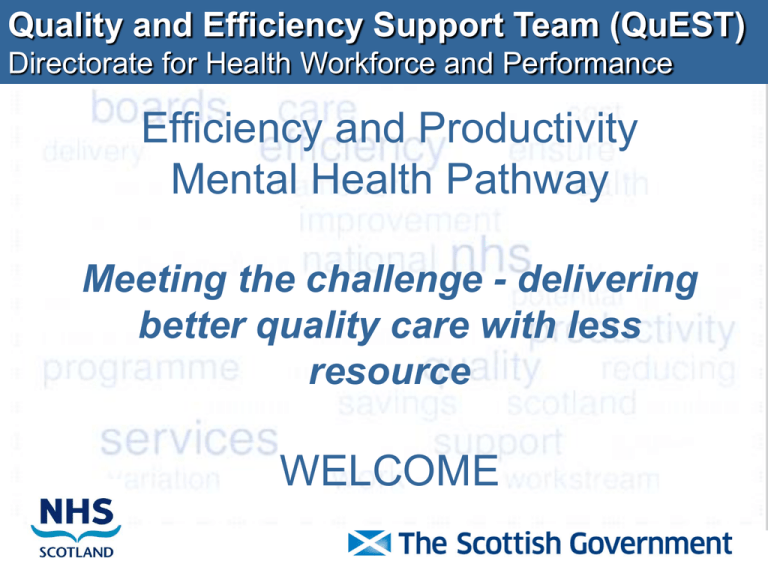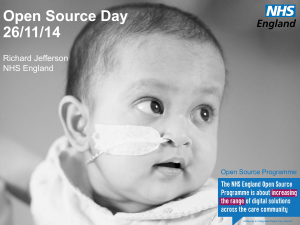Opening Presentation - Quality Improvement Hub
advertisement

Quality and Efficiency Support Team (QuEST) Directorate for Health Workforce and Performance Efficiency and Productivity Mental Health Pathway Meeting the challenge - delivering better quality care with less resource WELCOME Quality and Efficiency Support Team (QuEST) Directorate for Health Workforce and Performance Efficiency and Productivity Mental Health Pathway The challenge ahead… Ruth Glassborow, Mental Health Lead, QuEST Mental Health – The Challenge • One of the top public health challenges. Mental illness: – affect more than a third of population each year – second largest contributor to the burden of disease (19% of DALYs) – account for just under 40% of years lived with disability • Challenge of doing more with less: – significantly undertreated but growing levels accessing treatment – increasing prevalence of dementia • Growing evidence of extra physical health costs associated with mental illness Reframing the Challenge TACTICAL STRATEGIC PRODUCTIVITY & EFFICIENCY SERVICE OPTIMISATION CRES DEALING WITH THE 5% TRANSFORMATION SPENDING THE 95% BETTER Mental Health Efficiency and Productivity What we set out to do… • Key opportunities for productivity and efficiency savings • Assessment of productive opportunity • Key actions to release productive opportunity • Additional work nationally to support NHS Boards in realising productive opportunity Improving quality whilst reducing costs Key Themes • Evidence Based Care • Removing unwarranted variation and waste • Maximising the potential of the workforce • Prevention of illness and relapse • Self Management • Co-production • Involvement of families and communities We recognise that not all variation is bad and indeed some is good and necessary What is going on in your system? •Identify variation •Understand the variation •Act to reduce quality issues Literature Review Key Productive Opportunities Expert Opinion Stakeholder Opinion Benchmarking Data In addition the group highlighted Long Term Conditions and Mental Health, Better response to people with Borderline Personality Disorder, Out of Area Admissions/Independent Contracting and Proactive Management of Medically Unexplained Symptoms as areas where further work is needed to assess the productive opportunity and/or the key actions for releasing them. Optimising the number of psychiatric beds through effective community services and infrastructures Inpatient/Community Balance • Effective alternatives to inpatient admission and facilitating early discharge • Crisis prevention approaches including targeting high risk groups for admission Hypothesis - significant quality gains and efficiency savings attached to preventing the crisis occurring in the first place. Inpatient/Community Balance Figure 1a: Two-fold variation in bed days for all adult psychiatric admissions Bed days per 100,000 population Bed days per 100,000 NRAC adjusted population for all Adult Mental Health admissions by NHS Board and Specialty 2009/10 40,000 35,000 30,000 25,000 20,000 15,000 10,000 5,000 0 NHS Grampian NHS Borders NHS Ay rshire & Arran NHS Dumf ries & Galloway NHS Greater NHS Lothian NHS Tay side Glasgow & Cly de NHS Forth Valley NHS Highland NHS Fif e NHS Board G1 - General Psychiatry G4 - Psychiatry of Old Age Scotland Total NHS Lanarkshire NHS Western Isles Inpatient/Community Balance Five-fold variation in bed days for admissions with a primary diagnosis of psychoactive substance misuse (including WI fifteen fold) Bed days per 100,000 NRAC adjusted population for admissions with a primary diagnosis of Psychoactive Substance Misuse by NHS Board 2009/10 Bed days per 100,000 Population 3000 2500 2000 1500 1000 500 0 NHS Western Isles NHS Grampian NHS Fife NHS Borders NHS Lothian NHS Tayside NHS Dumfries & Galloway NHS Highland Health Board Board Scotland NHS Greater Glasgow & Clyde NHS Forth Valley NHS Ayrshire & Arran NHS Lanarkshire Inpatient/Community Balance Five-fold variation in bed days for admissions with a primary diagnosis of adult personality and behavioural disorder (including WI forty fold) Bed days per 100,000 NRAC adjusted population for admissions with a primary diagnosis of adult personality and behavioural disorders by NHS Board 2009/10 Bed days per 100,000 Population 1200 1000 800 600 400 200 0 NHS Western Isles NHS Grampian NHS Tayside NHS Lothian NHS Fife NHS Highland NHS Borders NHS Lanarkshire Health Board Board Scotland NHS Greater Glasgow & Clyde NHS Dumfries & Galloway NHS Ayrshire & Arran NHS Forth Valley Inpatient/Community Balance Ten-fold variation in length of stay for older people with psychosis Average Length of Stay (days) Average Length of Stay (days) for admissions with a primary diagnosis of psychosis in G4 Psychiatry of Old Age by NHS Board 2009/10 900 800 700 600 500 400 300 200 100 0 NHS Fife NHS Dumfries & Gallow ay NHS Forth Valley NHS Grampian NHS NHS Lothian Ayrshire & Arran NHS Tayside NHS Western Isles NHS Greater Glasgow & Clyde NHS Board G4 - Psychiatry of Old Age Scotland G4 Total NHS Borders NHS Lanarkshire NHS Highland Next steps nationally • Coding of beds so can benchmark acute, rehab, intensive care and continuing care from April 2013. • Mental Health Strategy, Commitment 23 – Core data set to allow comparison of different crisis resolution/home treatment models – Identify key components of crisis prevention approaches Effective and Efficient Community Mental Health Services Efficient and Effective CMHTs • Reliable implementation of evidence based practice • Effective Team Working (addition following recent research) • Reducing DNAs (and CNAs) • Reducing unwarranted variation in new to follow-up ratios • Reducing time spent on non-value adding activities • Remove duplication of work between professionals, teams, sectors and agencies • Appropriate skill mix • Better use of technology Effective and Efficient Community Mental Health Services Nine-fold variation in DNAs as a % of new outpatient appointments for General Psychiatry DNAs as % of New Outpatient Appointments for General Psychiatry ( 2009/10) Just new DNAs moving to mean represents approx £1million productive opportunities across Scotland. 40.0 35.0 30.0 % DNAs 25.0 20.0 15.0 10.0 5.0 0.0 B o rders Western Isles Grampian Shetland Islands Fife Orkney Islands Dumfries and Gallo way A yrshire and A rran NHS Board Lo thian Tayside Greater Lanarkshire Glasgo w and Clyde Highland Fo rth Valley Effective and Efficient Community Mental Health Services Seven-fold variation in DNAs as a % of new outpatient appointments for Old Age Psychiatry DNAs as % of New Outpatient Appointments for Psychiatry of Old Age (2009/10) 20.0 18.0 16.0 14.0 %DNAs 12.0 10.0 8.0 6.0 4.0 2.0 0.0 Borders Grampian Tayside Lothian Dumfries and Gallow ay Fife NHS Board Greater Ayrshire and Glasgow and Arran Clyde Forth Valley Lanarkshire Highland Effective and Efficient Community Mental Health Services Three-fold variation in ratio of new to returns for General Psychiatry outpatient appointments Return to New Ratio for General Psychiatry (2009/10) 12.0 8.0 6.0 4.0 2.0 Bo rd er s pi an ra m G La na rk sh i re ig hl an d H Va l le y Is le s NHS Board Fo rth an d sh i re Ay r W es te rn Ar r an ly de C an d Is la nd s la sg ow re at er G G s um fri e D Sh et la nd an d G al lo w ay Fi fe Lo th ia n Ta ys id e rk ne y Is la nd s 0.0 O Return to New Ratio 10.0 Effective and Efficient Community Mental Health Services Five-fold variation in ratio of new to returns for Psychiatry of Old Age outpatient appointments Return to New Ratio for Psychiatry of Old Age (2009/10) 7.0 6.0 Return to New Ratio 5.0 4.0 3.0 2.0 1.0 0.0 Lothian Lanarkshire Dumf ries and Gallow ay Fif e Greater Glasgow and Clyde Ayrshire and Arran NHS Board Grampian Forth Valley Borders Highland Tayside Effective and Efficient Community Mental Health Services Indirect Clinical Role Agency Tasks Activity Direct Clinical Percentage of average hours per week by activity - All Charge Nurses Individual Follow-up Other Assessment 1% Case Review (inc. CPA) Group Therapy 0% Clinical Admin 45% Other Clinical Meeting Attendance Telephone - other agency Travel 29% Meetings (non-clinical) Training/CPD 2% Supervision 1% Other 14% 26% 0% 6% 5% 24% 10% 6% 5% 14% 7% 5% 5% 10% 15% Percentage of Hours 20% 25% Next steps nationally • Effective and Efficient CMHT Toolkit – prototype being launched today • Database to reduce analytical time needed for activity trackers • Address quality of national staffing data so have credible comparative info on costs • Producing example set of Quality and Productivity Reports (QDCAQ) for Community Mental Health Services Telehealth/Telecare (Making better use of new (and not so new) technologies) Telehealth/Telecare • Video conferencing to improve access and reduce travel • Telephone/Webex to improve access & reduce travel • SMS Technology • Better use of technology to streamline admin processes • Better use of new technologies for self management, peer to peer support, self assessment, self referral and co-delivery of care Main barriers to adoption of telehealth/care • Awareness of potential opportunities • Set up costs • Cultural barriers Next steps nationally • National telehealth/care strategy • Project Ginsberg Early detection and intervention in psychosis Early Detection and Intervention in Psychosis Five-fold variation in bed days for admissions with a primary diagnosis of psychosis for individuals aged 18-24 years Bed days per 100,000 NRAC adjusted population for admissions 18-24 years old with a primary diagnosis of psychosis by NHS Board 2009/10 Bed days per 100,000 population 14,000 12,000 10,000 8,000 6,000 4,000 2,000 0 NHS Greater NHS Glasgow & Lanarkshire Clyde NHS Grampian NHS Lothian NHS Fife NHS Forth Valley NHS Ayrshire & Arran NHS Dumfries & Gallow ay NHS Board NHS Board 18-24's Scotland 18-24's NHS Borders NHS Tayside NHS Highland Next Steps Mental Health Strategy Commitment • Identify key components that need to be in place within every mental health service to enable early intervention services to respond to first episode psychosis and encourage adoption of first episode psychosis teams where that is a sensible option Other Issues for Consideration /Further Work • Dementia in General Hospitals • Long Term Conditions and Mental Health co-morbid mental health problems raise total healthcare costs by at least 45% • Borderline personality disorder • Out of area admissions and independent contracting • Proactive management of medically unexplained symptoms • Mental Health Promotion/Prevention This work made considerable use of benchmarking data… • Help to identify opportunities for improvement rather than the basis of judgements • Needs to be complimented by other techniques • Assessing practice against evidence base • Process mapping • Service User Experiences Benchmarking data – not just the scorecard • Even more indicators are included in the toolkit. • Summary of all the indicators on each table and an example of the type of information in the toolkit (which is in addition to the scorecard) Table Discussions • Have you been/do you think you can use the NHS Scotland Variation in Mental Health Activity report to inform work locally? • Do you ever use the national benchmarking scorecard and/or toolkit? • If your answer to either of the above is no, what needs to change so you can use national benchmarking data? • Do you have any insights into the reasons behind any of the significant variation highlighted in the NHS Scotland Variation in Mental Health Activity report? • What additional national data would you find useful to support you in identifying unwarranted variation and waste locally? • What work are you progressing locally around balanced scorecards/dashboards which will help in identifying key quality and efficiency opportunities? Quality and Efficiency Support Team (QuEST) Directorate for Health Workforce and Performance Feedback Quality and Efficiency Support Team (QuEST) Directorate for Health Workforce and Performance Efficiency and Productivity Mental Health Pathway Meeting the challenge - delivering better quality care with less resource Quality and Efficiency Support Team (QuEST) Directorate for Health Workforce and Performance Efficiency and Productivity Mental Health Pathway Meeting the challenge - delivering better quality care with less resource Quality and Efficiency Support Team (QuEST) Directorate for Health Workforce and Performance Efficiency and Productivity Mental Health Pathway Meeting the challenge - delivering better quality care with less resource Quality and Efficiency Support Team (QuEST) Directorate for Health Workforce and Performance Efficiency and Productivity Mental Health Pathway Meeting the challenge - delivering better quality care with less resource







